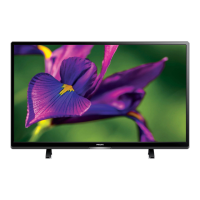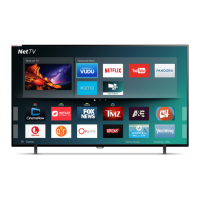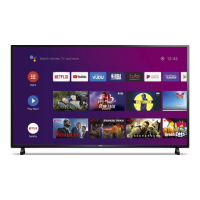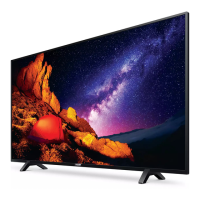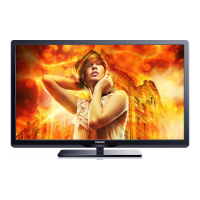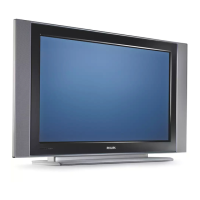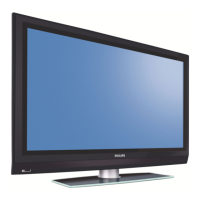Do you have a question about the Philips 50PFT5300 and is the answer not in the manual?
Connect your TV to the internet to access a world of television, apps, and online services.
Temporarily pause live TV broadcasts and record programs using a connected USB Hard Drive for later viewing.
Understand and follow all safety instructions before using the TV to ensure safe operation and prevent potential hazards.
Instructions on connecting the power cable securely to the TV and ensuring the plug remains accessible.
Steps to connect your TV to a wireless network, enabling internet access and network features.
Instructions for establishing a stable internet connection by connecting the TV to a router via a wired Ethernet cable.
Adjust network settings, including connection type, IP configuration, and media streaming options for optimal performance.
Connect and control HDMI CEC-compatible devices easily using the TV's remote control for enhanced convenience.
Connect your Home Theatre System (HTS) to the TV for an immersive audio experience, utilizing HDMI ARC for sound return.
Connect game consoles using HDMI or component video cables for the best gaming visuals and audio.
Connect a USB Hard Drive to pause live TV broadcasts and record your favorite programs for later viewing.
Utilize your TV as a monitor for your computer, connecting via HDMI or DVI for enhanced productivity.
Learn how to turn the TV on, switch it to standby mode, or turn it off completely for power management.
A comprehensive guide to all buttons on the remote control and their respective functions for TV operation.
Learn how to watch TV channels, switch between them, create favorite lists, and manage channel settings.
Instructions for installing new channels, updating channel lists, and performing channel scans for optimal reception.
Learn how to record TV programs instantly or schedule recordings using the TV guide and a USB Hard Drive.
Instructions for recording live TV programs instantly or scheduling future recordings using the TV guide.
Discover the Smart TV features, including internet connectivity, apps, and online services for an enhanced entertainment experience.
Configure your internet connection and set up Smart TV, including registration and parental controls for secure access.
Access and adjust various TV settings, including picture, sound, channel, network, and general preferences.
Instructions for updating the TV software via USB or the internet to ensure optimal performance and features.
Solutions for common TV problems related to channels, general operation, picture, sound, and connections.
Essential safety instructions and precautions to prevent injury, electric shock, fire hazards, and damage to the TV.
Connect your TV to the internet to access a world of television, apps, and online services.
Temporarily pause live TV broadcasts and record programs using a connected USB Hard Drive for later viewing.
Understand and follow all safety instructions before using the TV to ensure safe operation and prevent potential hazards.
Instructions on connecting the power cable securely to the TV and ensuring the plug remains accessible.
Steps to connect your TV to a wireless network, enabling internet access and network features.
Instructions for establishing a stable internet connection by connecting the TV to a router via a wired Ethernet cable.
Adjust network settings, including connection type, IP configuration, and media streaming options for optimal performance.
Connect and control HDMI CEC-compatible devices easily using the TV's remote control for enhanced convenience.
Connect your Home Theatre System (HTS) to the TV for an immersive audio experience, utilizing HDMI ARC for sound return.
Connect game consoles using HDMI or component video cables for the best gaming visuals and audio.
Connect a USB Hard Drive to pause live TV broadcasts and record your favorite programs for later viewing.
Utilize your TV as a monitor for your computer, connecting via HDMI or DVI for enhanced productivity.
Learn how to turn the TV on, switch it to standby mode, or turn it off completely for power management.
A comprehensive guide to all buttons on the remote control and their respective functions for TV operation.
Learn how to watch TV channels, switch between them, create favorite lists, and manage channel settings.
Instructions for installing new channels, updating channel lists, and performing channel scans for optimal reception.
Learn how to record TV programs instantly or schedule recordings using the TV guide and a USB Hard Drive.
Instructions for recording live TV programs instantly or scheduling future recordings using the TV guide.
Discover the Smart TV features, including internet connectivity, apps, and online services for an enhanced entertainment experience.
Configure your internet connection and set up Smart TV, including registration and parental controls for secure access.
Access and adjust various TV settings, including picture, sound, channel, network, and general preferences.
Instructions for updating the TV software via USB or the internet to ensure optimal performance and features.
Solutions for common TV problems related to channels, general operation, picture, sound, and connections.
Essential safety instructions and precautions to prevent injury, electric shock, fire hazards, and damage to the TV.
| Screen shape | Flat |
|---|---|
| Response time | - ms |
| Display diagonal | 50 \ |
| Display brightness | 300 cd/m² |
| Native aspect ratio | 16:9 |
| Native refresh rate | 60 Hz |
| LED backlighting type | - |
| Display diagonal (metric) | 126 cm |
| Screen format adjustments | Zoom |
| Motion interpolation technology | PMR (Perfect Motion Rate) 200 Hz |
| 3D | No |
| Interactive TV | Yes |
| Annual energy consumption | 62 kWh |
| Tuner type | Analog & digital |
| Analog signal format system | NTSC, PAL, SECAM |
| Digital signal format system | DVB-C, DVB-T, DVB-T2 |
| Music apps | Spotify |
| Video apps | YouTube |
| RMS rated power | 20 W |
| DVI-D ports quantity | 0 |
| USB 2.0 ports quantity | USB 2.0 ports have a data transmission speed of 480 Mbps, and are backwards compatible with USB 1.1 ports. You can connect all kinds of peripheral devices to them. |
| Component video (YPbPr/YCbCr) in | 1 |
| Consumer Electronics Control (CEC) | EasyLink |
| Wi-Fi standards | Wi-Fi 4 (802.11n) |
| Audio formats supported | AAC, MP3, WAV, WMA |
| Image formats supported | BMP, GIF, JPG, PNG |
| Video formats supported | AVC, AVI, H.264, MKV, MPEG1, MPEG2, MPEG4, VC-1, WMV9 |
| Subtitle formats supported | ASS, SMI, SRT, SSA, SUB, TXT |
| Product color | Black |
| Panel mounting interface | 400 x 200 mm |
| AC input voltage | 220 - 240 V |
| AC input frequency | 50 - 60 Hz |
| Power consumption (standby) | 0.3 W |
| Power consumption (typical) | 43 W |
| Package depth | 131 mm |
| Package width | 1380 mm |
| Package height | 796 mm |
| Package weight | 20500 g |
| Operating temperature (T-T) | 5 - 35 °C |
| Cables included | AC |
| Depth (with stand) | 259 mm |
|---|---|
| Height (with stand) | 709 mm |
| Weight (with stand) | 15500 g |
| Depth (without stand) | 77 mm |
| Width (without stand) | 1124 mm |
| Height (without stand) | 647 mm |
| Weight (without stand) | 12900 g |

